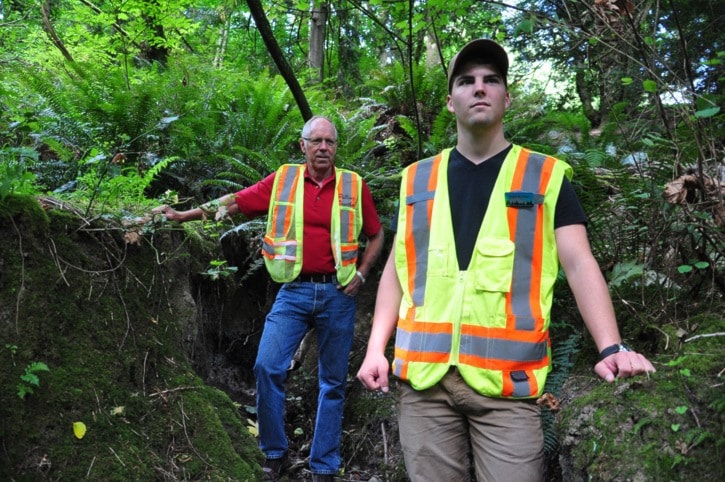At the creek’s edge in Mount Doug Park, Georg Dischner spots a food wrappers on the ground, shakes his head, and stuffs the trash in his pocket.
The park has become the daily stomping ground for the young Bavarian. The Douglas fir and cedar forest, creeks and beach are like his office, but people keep junking up his workspace.
Dischner, 22, is the Friends of Mount Douglas Park Society’s first ever summer intern, a student in forest management from the Munich Technical University, in Germany. He found the 181-hectare park, and the society, over the Internet.
“Mount Doug is such a great natural area, and it has such a good website and pictures. It impressed me a lot and I was able to learn about it 9,000 kilometres away,” Dischner says. “I decided it looked like a good place for an internship.”
“It is perfect here. The Saanich district is beautiful,” he adds. “Getting to work here every day is impressive.”
In partnership with the Saanich parks department, the society has kept Dischner busy with plant surveys along Douglas creek, learning techniques for restoring salmon habitat, locating danger trees and pulling invasive plant species, although he admits part of his time also involves picking up garbage.
“I don’t get that. People come here to enjoy nature and then pollute it,” Dischner says. “People who visit the park should be concerned about the natural areas. I find the doggy bags every day.”
The Friends of Mount Doug will use Dischner’s expertise on forest sustainability to make headway in reducing flooding through the forest floor, and silt buildup in the salmon-bearing creek. It’s a long-term problem that threatens to undo years of painstaking restoration efforts.
“An intern is new for us, but we certainly welcome Georg,” says park society president Darrell Wick. “His university training especially fits what we need. His skills are what we don’t have.
“We are lining him up with as many different experiences as possible. I haven’t found something he can’t do yet. He’s keen to learn everything.”
With Dischner and Wick in their official looking work vests, we walk to a vantage point above Douglas creek, a few hundred metres before it reaches the ocean. Wick describes the difficult process to haul in gravel, rocks and woody debris down the ravine, which has given coho and chum a fighting chance to spawn, without eggs being washed away in storm surges.
Some years they’ll see 100 salmon in the creek, some years less. During the winter volunteers also seed the creek and tributaries with salmon carcasses to introduce nutrients to the soil. Salmon tossing has become a community event.
“Carcasses are important to the trees. If you haven’t thrown a carcass, you haven’t lived,” Wick laughed. “Chum is nature’s fertilizer. You can measure it in the trees.”
This year they plan more of the same – positioning logs and boulders to create deeper creek beds and pools. Much of the work is an effort to slow down winter stormwater that can barrel through the park ecosystem like a freight train.
When Gordon Head was farmland, rain percolated into the forest slowly. Replace that with roads, roofs and driveways, and the rain suddenly has no brakes, Wicks points out. Most of the stormwater in this part of Saanich empties into the creek through a weir.
“The weir acts as settling point for silt. Pollutants will float and pipes are below,” says Wick, a 22-year volunteer with the park society. “The theory is there’s cleaner water. But (the weir) is under designed. It doesn’t take much rain to flow over.”
We walk over boardwalk ties half sunk into the earth in the forest below Mount Doug, and Wick points out exposed roots of Douglas firs, victims of a chain reaction of silt filling a marsh area, leading to flooding through the forest over the winter.
“That tree went over, that tree went over,” he says of Douglas firs lying across the forest floor, felled by wind and weak roots. “Douglas firs don’t like wet roots.”
Georg enjoys this more obscure area of the forest, below the road that splits the park. You can’t hear traffic and there are few dog walkers. He sets off to start his tasks for the day.
“I like this park area. I get to work in the creek, and pulling invasives. It’s quiet,” he says. Every place in the park is beautiful.”
editor@saanichnews.com
